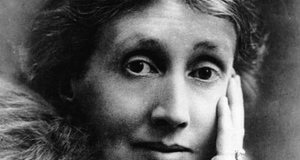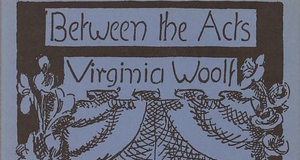Depending on Distance: Mrs. Ramsay as Artist and Inspiration in Virginia Woolf's To the Lighthouse
By
2014, Vol. 6 No. 06 | pg. 2/2 | « Beyond the mirroring of actions, though, it is important to note the effect that Mrs. Ramsay and her work have on Lily. The dinner party serves as the catalyst for Lily’s epiphany regarding her own art. While watching Mrs. Ramsay and the other guests at the table, Lily suddenly realizes that if she were to “put the tree further in the middle,” she would then “avoid that awkward space” (p. 87). She proceeds to use a “salt cellar” and the flower pattern on the tablecloth as a reminder to herself of this decision to change her painting. This choice by Woolf—to have Lily utilize items that exist within the scene rather than perhaps stop to write a note to herself—heightens the meaning of the dinner party for two reasons. First, it keeps Lily engaged in the scene both as observer and participant; second, it increases the utensils’ and decorations’ value as works of art, as they represent the tree and background in Lily’s painting. While this choice on Woolf’s part serves to raise Mrs. Ramsay’s creation to the realm of art, it also sets it apart as necessary for Lily’s completion of her own work. While this reading of the dinner party as a work of art supports the idea that Mrs. Ramsay is herself an artist—a “social artist” as Ronchetti (2004) calls her in The Artist, Society & Sexuality in Virginia Woolf’s Novels—it is important to note that Lily’s reflections on her decision to move the tree occur at moments in which she is faced with aspects of society inherent to the dinner party that she believes would attempt to undermine her art. First, when forced to make conversation with Mr. Tansley, who has said, “women can’t write, women can’t paint,” she reminds herself: “I must move the tree to the middle; that matters—nothing else” (Woolf, 1927/2005, p. 88). This mental trick of focusing on her art to make conversation bearable seems to work as we find Lily again noticing the symbols she has set up to remind herself, “and she remembered that next morning she would move the tree further towards the middle, and her spirits rose so high at the thought of painting tomorrow that she laughed out loud at what Mr. Tansley was saying. Let him talk all night if he liked it” (p. 95). But this remembering saves her from more than just uncomfortable conversation. Later, when faced with Paul and Minta’s engagement, “she said to herself, catching sight of the salt cellar on the pattern, she need not marry, thank Heaven: she need not undergo that degradation. She was saved from that dilution. She would move the tree rather more to the middle” (p. 104). Lily’s is an obvious rejection of social roles that Mrs. Ramsay’s dinner party propagates. Rather than buying into the ideas and expectations that Mrs. Ramsay and her art espouse, Lily is strengthened by her own art in opposition to them. She will play along with the conversation just to get through the night, but she will not spend her life doing the same. While she is inspired in her own art by Mrs. Ramsay, she is not tempted to change course or to follow in Mrs. Ramsay’s footsteps. In the clear distinction drawn between Lily’s art and Mrs. Ramsay’s we see that, while Mrs. Ramsay’s artistic endeavor succeeds in the bringing together of people, Lily’s is dependent upon her remaining separate and unattached. And yet, despite these differences, as well as the myriad similarities in their creations, we find both women’s works of art ultimately described by the respective artists as failures, once again mirroring each other. The dinner party, while a momentary success of which “the thing is made that endures” (p. 107), ultimately becomes “a scene that was vanishing even as [Mrs. Ramsay] looked...it had become...already the past” (p. 114). Its success is no more than a passing flash of brilliance, like the lighthouse beam sweeping past. Similarly, we learn that, though Paul and Minta did indeed marry, “the marriage had not been a success” (p. 177). Even Mrs. Ramsay’s careful planning and arranging of walks and seating partners cannot make a relationship last when it is not meant to be. Likewise, in the closing lines of the novel, just as she is about to finish her painting, Lily realizes the quickly approaching fate of her own art: “It would be hung in the attics, she thought; it would be destroyed” (p. 211). So in their conclusions, as in their descriptions, we find Mrs. Ramsay’s work to mirror Lily’s, and Lily’s to reflect back Mrs. Ramsay’s. Each bound to fall short of its artist’s hope to create something lasting, something permanent.But perhaps there is a glimmer of hope for them both. Returning to the idea of Mrs. Ramsay making Lily’s art possible, we find Lily, years later, finally ready to complete her painting: Suddenly she remembered. When she had sat there last ten years ago there had been a little sprig or leaf pattern on the table-cloth, which she had looked at in a moment of revelation. There had been a problem about a foreground of a picture. Move the tree to the middle, she had said. She had never finished that picture. She would paint that picture now. It had been knocking about in her mind all these years. (p. 151) She thinks back to the evening of the dinner party and the solution it inspired and suddenly Mrs. Ramsay’s artistic endeavor has resurfaced, has emerged from its tomb despite the fact that Mrs. Ramsay herself will never do the same. But even with this memory, Lily is still unable to complete her work. She works with brown paint (p. 161). She “began precariously dipping among the blues and umbers, moving her brush hither and thither” (p. 163). And as she paints, she thinks back to Mrs. Ramsay on the beach writing letters and recognizes Mrs. Ramsay’s influence even on her memory of events and her relationship to Mr. Tansley and notes: “and there it stayed in the mind affecting one almost like a work of art” (p. 164). Then she remembers: This, that, and the other; herself and Charles Tansley and the breaking wave; Mrs. Ramsay bringing them together; Mrs. Ramsay saying, ‘Life stand still here’; Mrs. Ramsay making of the moment something permanent (as in another sphere Lily herself tried to make of the moment something permanent)—this was the nature of revelation. (p. 165) When at last Lily “drew a line there, in the centre” and puts down her brush, she realizes: “I have had my vision” (p. 211). But this vision is much larger than the picture she has just painted. It is a vision of life and of art, of connection and of what lasts and what is permanent. Though she has just thought to herself that her painting will not be seen but rather destroyed, it is through her memory of Mrs. Ramsay and her dinner party that she is able to complete the painting. Mrs. Ramsay left her dinner party that night with the realization that it was “...already the past,” and yet it was this past that inspired Lily to the completion of her own project. As Lily notes, “so much depends...upon distance” (p. 194). Lily had this distance from Mrs. Ramsay, but not from her own work so, although it is the similarities to Lily’s work that illuminates Mrs. Ramsay’s as art, it is Mrs. Ramsay’s lasting influence that provides the hope that just maybe Lily has created something permanent. Only the distance of time will tell. ReferencesRonchetti, A. (2004). The Artist, Society & Sexuality in Virginia Woolf’s Novels. New York, NY: Routledge. Wirth-Nesher, H. (1976). Form as fate: Everyman as artist in Virginia Woolf’s To the Lighthouse. Bucknell Review, 22(2), 71-80. Woolf, V. (2005). To the Lighthouse. Orlando, FL: Harcourt. (Original work published 1927). Suggested Reading from Inquiries Journal
Inquiries Journal provides undergraduate and graduate students around the world a platform for the wide dissemination of academic work over a range of core disciplines. Representing the work of students from hundreds of institutions around the globe, Inquiries Journal's large database of academic articles is completely free. Learn more | Blog | Submit Latest in Literature |
















